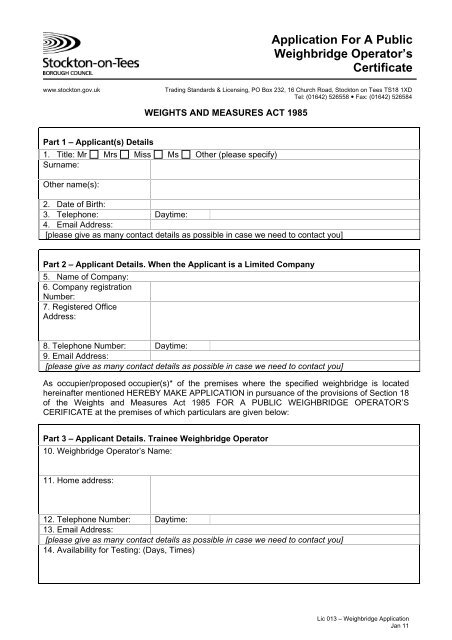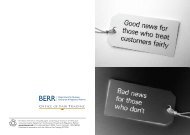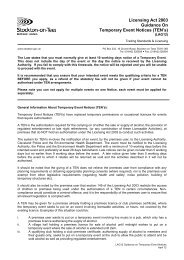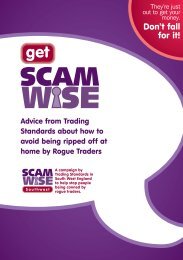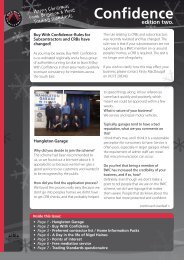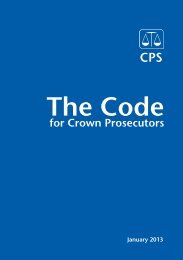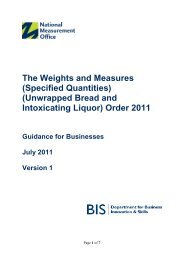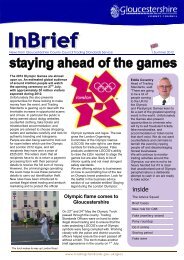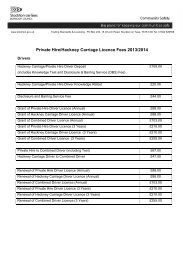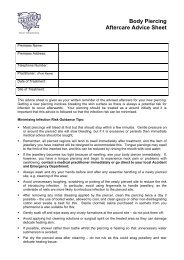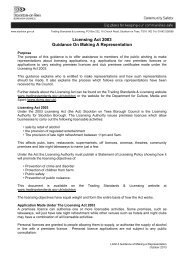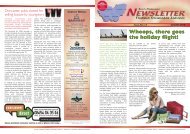View - Trading Standards Institute
View - Trading Standards Institute
View - Trading Standards Institute
You also want an ePaper? Increase the reach of your titles
YUMPU automatically turns print PDFs into web optimized ePapers that Google loves.
Application For A Public<br />
Weighbridge Operator’s<br />
Certificate<br />
www.stockton.gov.uk<br />
<strong>Trading</strong> <strong>Standards</strong> & Licensing, PO Box 232, 16 Church Road, Stockton on Tees TS18 1XD<br />
Tel: (01642) 526558 • Fax: (01642) 526584<br />
WEIGHTS AND MEASURES ACT 1985<br />
Part 1 – Applicant(s) Details<br />
1. Title: Mr Mrs Miss Ms Other (please specify)<br />
Surname:<br />
Other name(s):<br />
2. Date of Birth:<br />
3. Telephone: Daytime:<br />
4. Email Address:<br />
[please give as many contact details as possible in case we need to contact you]<br />
Part 2 – Applicant Details. When the Applicant is a Limited Company<br />
5. Name of Company:<br />
6. Company registration<br />
Number:<br />
7. Registered Office<br />
Address:<br />
8. Telephone Number: Daytime:<br />
9. Email Address:<br />
[please give as many contact details as possible in case we need to contact you]<br />
As occupier/proposed occupier(s)* of the premises where the specified weighbridge is located<br />
hereinafter mentioned HEREBY MAKE APPLICATION in pursuance of the provisions of Section 18<br />
of the Weights and Measures Act 1985 FOR A PUBLIC WEIGHBRIDGE OPERATOR’S<br />
CERIFICATE at the premises of which particulars are given below:<br />
Part 3 – Applicant Details. Trainee Weighbridge Operator<br />
10. Weighbridge Operator’s Name:<br />
11. Home address:<br />
12. Telephone Number: Daytime:<br />
13. Email Address:<br />
[please give as many contact details as possible in case we need to contact you]<br />
14. Availability for Testing: (Days, Times)<br />
Lic 013 – Weighbridge Application<br />
Jan 11
Part 4 – Weighbridge Details<br />
Please provide details about the weighbridge where the operator is to be tested.<br />
15. Location of Weighbridge:<br />
Name of Premises/Company<br />
16. Address of Weighbridge:<br />
17. Describe the exact location of the weighbridge on the premises:<br />
18. Type of Weighbridge:<br />
Make, Model, Capacity and Type (e.g. digital, chart, steelyard)<br />
Part 5 – Additional Details<br />
Provide any additional information which may be required or relevant to the application.<br />
Part 6 – Declaration and Checklist (please tick)<br />
I/WE are aware of the provisions of the Weights and Measures Act 1985<br />
I/We* confirm that, to the best of my/our* knowledge and belief, the information contained<br />
in this application is true.<br />
How We Collect And Use Information<br />
The information collected, on this form and from supporting evidence, by Stockton-On-Tees Borough Council will be<br />
used to process your application. The information may be passed to other Enforcement Agencies as permitted by law.<br />
We may check information provided by you, or information about you provided by a third party, with other information held<br />
by us. We may also get information from certain third parties, or give information to them to check the accuracy of<br />
information, to prevent or detect crime, or to protect public funds in other ways, as permitted by law. These third parties<br />
include Government Departments and local authorities.<br />
We will not disclose information about you to anyone outside Stockton-On-Tees Borough Council nor use information<br />
about you for other purposes unless the law permits us to.<br />
Stockton-On-Tees Borough Council is the Data Controller for the purposes of the Data Protection Act 1998. If you want<br />
to know more about what information we have about you, or the way we use your information, you can ask at:<br />
<strong>Trading</strong> <strong>Standards</strong> and Licensing, PO Box 232, 16 Church Road, Stockton-On-Tees, TS18 1XD<br />
Lic 013 – Weighbridge Application<br />
Jan 11
Part 7 – Signature(s)<br />
19. Signature of applicant or applicant’s solicitor or other duly authorised agent. If signing on behalf<br />
of the applicant, please state in what capacity:<br />
Signature:<br />
Print Name:<br />
Capacity:<br />
Date:<br />
20. For joint applications, signature of 2 nd applicant, or 2 nd applicant’s solicitor or other authorised<br />
agent. If signing on behalf of the applicant, please state in what capacity:<br />
Signature:<br />
Print Name:<br />
Capacity:<br />
Date:<br />
Part 8 – Contact Details<br />
21. Please give the name of a person who can be contacted about the application:<br />
22. Please give one or more telephone numbers at which the person identified in question 21 can be<br />
contacted:<br />
Daytime:<br />
Mobile:<br />
Evening:<br />
23. Postal address for correspondence associated with this application:<br />
Postcode:<br />
24. If you are happy for correspondence in relation to your application to be sent via e-mail, please<br />
give the e-mail address below:<br />
Return completed form to:<br />
Stockton-On-Tees Borough Council<br />
<strong>Trading</strong> <strong>Standards</strong> & Licensing<br />
PO Box 232<br />
16 Church Road<br />
Stockton-On-Tees<br />
TS18 1XD<br />
FOR OFFICIAL USE ONLY<br />
Inspector carrying out test…………………….<br />
Date of Test …………………………………....<br />
Recommendation ……………………………………………………………………………………………<br />
Date reported to Chief inspector of Weights and Measures………………………………….…………<br />
Decision…………………………..…………….<br />
Lic 013 – Weighbridge Application<br />
Jan 11
Public Weighbridge Operators Guidance<br />
Qualifications Required<br />
Operators of public weighing equipment have responsibilities to ensure that they can perform their duties<br />
competently and honestly. Further, no one may operate public weighing equipment unless he/she holds a<br />
certificate from a Chief <strong>Trading</strong> <strong>Standards</strong> Officer.<br />
Applicants for a certificate will be tested verbally and practically by an Inspector and will be required to<br />
show that they can<br />
a. operate the weighbridge satisfactorily<br />
b. complete any weighbridge tickets and associated documentation satisfactorily<br />
c. understand basic terms associated with the operation of a weighbridge<br />
d. understand their duties as a weighbridge operator<br />
e. understand potential frauds which may unknowingly be assisted by a weighbridge operator<br />
f. understand how the accuracy of the weighbridge may be affected<br />
g. perform simple arithmetic (use of a calculator is permitted)<br />
Before applying for a test, please ensure that you have received sufficient training in the operation of the<br />
equipment and that you have completed the document shown in Appendix 1. This document will be<br />
required by the Inspector when he/she tests you.<br />
It is the policy of this authority to limit the scope of any certificate to the weighbridge the operator will be<br />
expected to use., should the weighbridge be replaced or changed a new certificate will be required.<br />
Weights and Measures Act 1985<br />
Section 18: Operators of public weighing equipment must hold a certificate of competence from a Chief<br />
<strong>Trading</strong> <strong>Standards</strong> Officer<br />
Section 19:<br />
i) must carry out a weighing on demand unless they have reasonable cause not to do so.<br />
ii) must carry out the weighing fairly<br />
iii) must give to the person requiring the weighing a written statement of the weight found<br />
iv) must make a record detailing:<br />
v) must not make a false record or give a false statement<br />
vi) must not commit any fraud<br />
vii) persons bringing an item to be weighed must, if requested, give his name and address to<br />
the operator<br />
viii) records of weighings must be retained for two years<br />
ix) record must not be destroyed or defaced within two years<br />
Weighing Equipment (EEC Automatic Weighing Machines) Regulations 1988<br />
Reg. 4(7) No person may carry out a ‘double weighing’ for trade purposes.<br />
TERMS<br />
Balance - When the weighbridge is unloaded the indication shows zero.<br />
Gross Weight - This is the weight of the vehicle fully laden, and is an indication of total weight of<br />
everything on the bridge.<br />
GVW - Gross Vehicle Weight<br />
Tare Weight - This is the weight of the unladen vehicle, i.e. the weight you will use to calculate the<br />
vehicle’s load.<br />
Net Weight - Gross weight less tare weight i.e. the weight of the load.<br />
Train Weight - Similar to gross weight and refers to the all-up weight of an articulated vehicle (tractor and<br />
trailer). On weighbridge documentation it will still be referred to as gross weight.<br />
Lic 013 – Weighbridge Application<br />
Jan 11
GTW - Gross Train Weight<br />
Headwork - The part of the machine which incorporates the weight indications.<br />
Bottom Work - The levers and/or loadcells below the plate.<br />
Plate/Platform - The part of the machine on which the load to be weighed is placed.<br />
Double-weighing - The weighing of a load or vehicle in two or more stages. e.g. where an articulated<br />
vehicle cannot fit onto the plate its weight is calculated from the sum of the front and rear sets of axle<br />
weights.<br />
Axle weighings - The weighing of individual axles or groups of axles to determine the load placed upon<br />
them.<br />
Draw Bar Unit - A rigid vehicle towing by means of a bar a self supporting trailer.<br />
Permitted GVW) Permitted GTW) - The legal maximum weight permitted on the road.<br />
Good Weighing Practice<br />
1. Regular checks should be made to ensure that there is clearance between the plate and its<br />
surrounding frame. If the weighing machine operates using a lever bottomwork the plate should<br />
swing freely endways.<br />
2. Regular checks should be made to ensure that the weighbridge is properly balanced when<br />
unloaded and the indicator shows zero. The Weighbridge Operator must know how to balance the<br />
weighing machine.<br />
3. The balance of a weighbridge will be affected by the accumulation of dirt etc. on or around the<br />
plate. This should be regularly cleaned to avoid any excessive build-up. Beneath the plate, levers<br />
or load cells may be affected by the build-up of dirt (sand) and should be cleared as necessary. If<br />
your weighbridge is prone to such contamination a regular maintenance programme should be<br />
implemented. In a pit mounted weighbridge, balance and accuracy may be affected by a high<br />
water level in the pit which ‘floats’ the levers or the bottomwork. In such circumstances pumping<br />
facilities should be available and the Weighbridge Operator will be expected to know how to use it.<br />
The most common cause of ‘balance’ error is due to rain on the plate. During periods of rain<br />
balance should be checked and adjusted more frequently and again as the plate dries.<br />
Weighing Procedures<br />
1. It is advisable to weigh all vehicles without passengers or driver.<br />
If this is not possible or if the personnel refuse to leave the vehicle a note should be made to this<br />
effect with details of the number of persons on the vehicle. This note should be made on the<br />
ticket and on any other record. This information is required because certain persons may wish to<br />
increase the GROSS weight of the load by addition of passengers and if and when the tare<br />
weight is taken without passengers the weight of the load appears heavier. Weighbridge<br />
Operators should take special care whilst passengers are on or in the vicinity of the plate.<br />
2. Where practical the Weighbridge Operator should check the load for himself and if this is not<br />
possible the ticket should indicate the load as stated by the driver. Weighbridge Operators should<br />
be aware that persons bringing loads to be weighed may conceal heavy items amongst the stated<br />
load. This heavy article can then be discarded and the goods delivered to a purchaser. e.g.<br />
Concrete blocks with scrap metal. The load is identified as scrap metal and following weighing the<br />
concrete is discarded and the scrap metal sold at the higher weight. Therefore the weighbridge<br />
ticket would be properly completed as ‘scrap metal/concrete’.<br />
3. The Operator should always check any vehicle registration number for himself rather than rely on<br />
the driver.<br />
4. The Weighbridge Operator should have a clear view of the plate and ensure the vehicle being<br />
weighed is positioned on the plate. Weighbridge Operators should be aware that persons requiring<br />
a weighing may deliberately leave a wheel over the edge of the plate to reduce the weight shown.<br />
This is either done to reduce the tare weight (and therefore increase the apparent weight of the<br />
load or to appear below the permitted legal weights for overloading purpose.<br />
5. It is illegal to undertake a double weighing where that weighing will be used for a trade transaction.<br />
e.g. a load of hay for sale elsewhere. Drivers sometimes require a weighing to ensure they are<br />
not overloaded on individual axles It is permissible to undertake weighings of individual axles<br />
but the ticket and records should clearly indicate what type of weighing was carried out and which<br />
axles were weighed etc. The ticket should be endorsed - "Weights found are not for trade<br />
purpose".<br />
Lic 013 – Weighbridge Application<br />
Jan 11
Weighbridge Ticket<br />
A Weighbridge Operator must give a statement in writing of the weight found to the person demanding<br />
the weighing or to his agent (this may be an arrangement made formally or informally but the statement<br />
should always go with the vehicle).<br />
They must enter the weight found in the GROSS or TARE box on the weighbridge ticket as appropriate.<br />
If the ticket is to be issued then the weighbridge operator must enter NOT WEIGHED or draw lines<br />
through the spaces provided for other entries. Operators MUST NOT enter in the tare box a weight<br />
STATED BY THE DRIVER, as only weights determined by the weighbridge operator should be inserted.<br />
If the driver intends to return after loading for a second weighing of the same vehicle to be recorded on<br />
the same ticket, the ticket should be retained until the second weighing is complete. A Weighbridge<br />
Operator should never give out a ticket that has any blank spaces.<br />
They must complete the other particulars required on the ticket.<br />
NOTE: Often when using an electronic headwork with ticket printer the information is fully or partly<br />
transferred onto the ticket. However, if this fails full records must still be kept and any calculations worked<br />
out accurately.<br />
Records<br />
The Weighbridge Operator must ensure that a record of each weighing is made. These records must be<br />
kept for at least 2 years. If the duplicate of the weighbridge ticket is the only record of the weighing, it<br />
must also state:<br />
• The time of weighing<br />
• The registration number of the vehicle (if applicable)<br />
• The weight found<br />
• The date<br />
• The nature of the load<br />
If a Weighbridge Operator suspects any irregularities in a request for, or the use of, public weighbridge<br />
weighings, their local <strong>Trading</strong> <strong>Standards</strong> office should be informed.<br />
The maximum penalty for fraud in connection with a public weighing is a fine of £5,000 or six months<br />
imprisonment, or both. The maximum penalty for recording a false weight is a fine of £5,000.<br />
Road Traffic Act (Vehicle Overloading)<br />
Whilst not strictly a matter for a certificated Weighbridge Operator this Authority would expect an operator<br />
to have a basic knowledge of vehicle weights.<br />
If, having weighed a vehicle, a Weighbridge Operator suspects the weights to be in excess of that<br />
permitted for the vehicle on the highway they should draw the driver’s attention to the weight record.<br />
Further, the ticket should be marked ‘vehicle possibly overloaded’.<br />
A Weighbridge Operator does not have authority to<br />
(a) withhold the weighbridge ticket<br />
(b) prevent the vehicle leaving.<br />
Lic 013 – Weighbridge Application<br />
Jan 11
Appendix 1<br />
Self Assessment Sheet<br />
(1) Can you confidently operate the weighing equipment<br />
(2) Where are the ‘copy ticket’ or records retained<br />
(3) Can you refuse to undertake a public weighing<br />
(4) If YES to (3), when<br />
(5) What details must be shown in the ‘records’<br />
(6) How long should records be retained<br />
(7) What do you understand by the terms<br />
• Balance<br />
• Net weight<br />
• Double weighing<br />
(8) What will happen to ‘balance’ when it rains<br />
(9 What will you do if passengers refuse to get out of a vehicle<br />
(10) If you cannot see the load, what will you do<br />
(11) The vehicle is too long to fit onto your weighbridge plate. What will you do<br />
(12) Why should you never leave blanks on a weighbridge ticket<br />
(13) Why should ‘people’ bringing articles for weighing try to mislead you.<br />
In preparing for your test please expect additional questions to those detailed above as these are for your<br />
benefit to judge your readiness.<br />
For further information or clarification please contact:<br />
<strong>Trading</strong> <strong>Standards</strong>, 16 Church Road, Stockton on Tees. TS18 1XD<br />
E-mail: tradingstandards@stockton.gov.uk.<br />
Telephone 01642 526560<br />
Lic 013 – Weighbridge Application<br />
Jan 11


